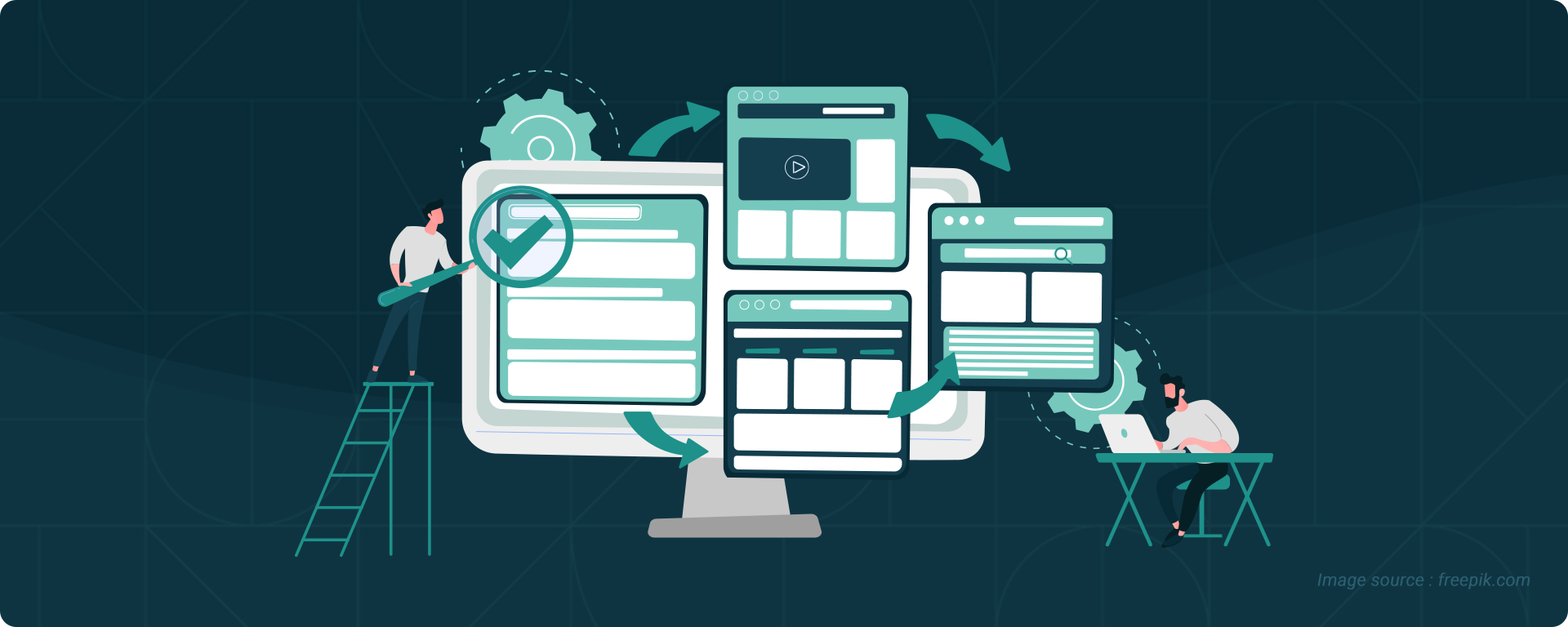The pandemic has accelerated the adoption of digital products and services by consumers, and as a result, it’s now essential that every small and medium business must achieve digital transformation of their business to achieve growth.
Additionally, digital transformation provides a way for businesses to leverage innovative new technologies and strategies to increase revenue, reduce costs, and improve operations to improve revenue streams, achieve goals faster and avoid being disrupted.
And in the case of small to mid-sized businesses, it can help you to compete with much larger businesses by placing you on equal terms.
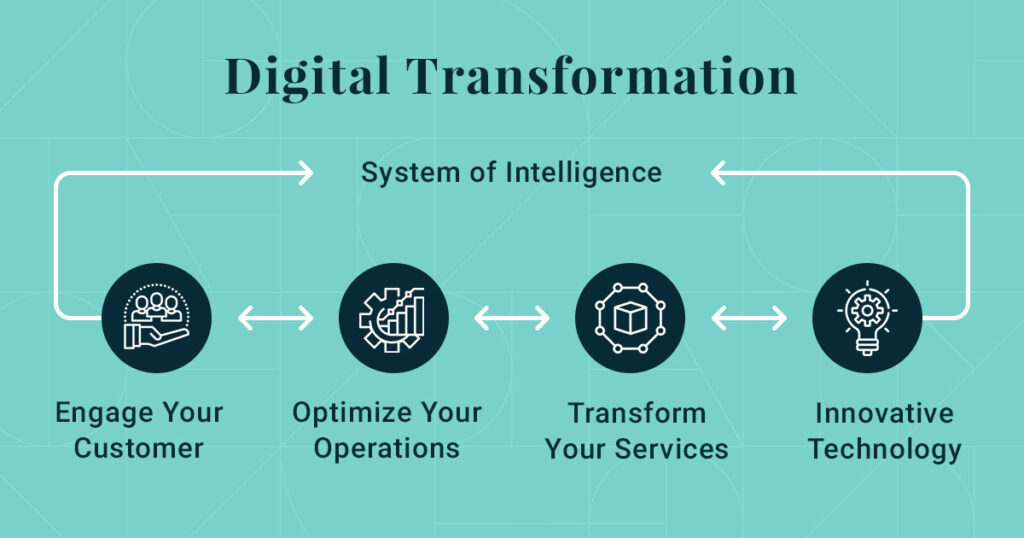
And while the road to a complete digital transformation might seem impossibly complicated, today, there is a logical process businesses can follow in a time and cost-efficient way to overcome this.
Ready to learn how digital transformation can impact your business?
If you’re reading this thinking, “where do I even start?” we’ve listed out some of the top business benefits of digital transformation, and how you can use it in your business to achieve growth:
- Delivering an enhanced customer experience
- Automate manual tasks to save time and money
- Data that delivers deep insights for smarter decisions, and better results
- Digital offers effective and inexpensive communication channels
- Future (crisis)-proofing your business
Delivering an enhanced customer experience
While digital transformation can impact virtually every aspect of a business, its most significant impact is on customer experience. Many of the technological advances in recent years, like eCommerce shopping and personalised content, have been mostly for the benefit of consumers.
When we say customer experience, we’re not just talking about a customer who came to your website and made a purchase. In reality, it’s a culmination of all the interactions and experiences your customer has with your business throughout the entire customer journey, from the first time they see your brand to the moment they make a purchase, and all interactions with them after.
Digital transformation offers small business owners a significant edge in this area because it helps to provide clarity on who exactly your ideal customers are, and which customers are not.

As a result, when you stop wasting your time and resources on the wrong customers and focus instead on the ideal customers, you can fine-tune your services/products to solve their biggest pain points, resulting in an enriched, and invaluable service for them.
When customers feel like a business understands their needs and provides the solutions they’re looking for, they are more likely to become not only repeat customers but also brand advocates!
On the other hand, keep in mind, customer experience doesn’t just include managing your customer relationships, but also everything from your website user experience right through to your digital marketing efforts.
Things like poor website navigation, unresponsive pages, and lack of real-time support to blindly launching marketing promotions with no clear strategy can all leave your customers feeling frustrated, confused of your message and create a poor impression of your business.
Digital transformation allows you to stay on top of your business by applying innovative tech solutions to manage everything customer experience related so that they feel comfortable putting their trust in you.
So, if you’re looking to improve the experience your business provides to customers, it’s time to start adapting to advances in technology and finding ways to focus on incorporating a digital strategy.
Automate manual tasks to save time and money
Most small businesses have some form of automation already in place, however, despite workflow automation playing such a huge role in digital transformation, a large percentage of small and medium businesses are yet to take advantage of the opportunities that exists to do simple and inexpensive automations on several aspects of their operations still done manually.
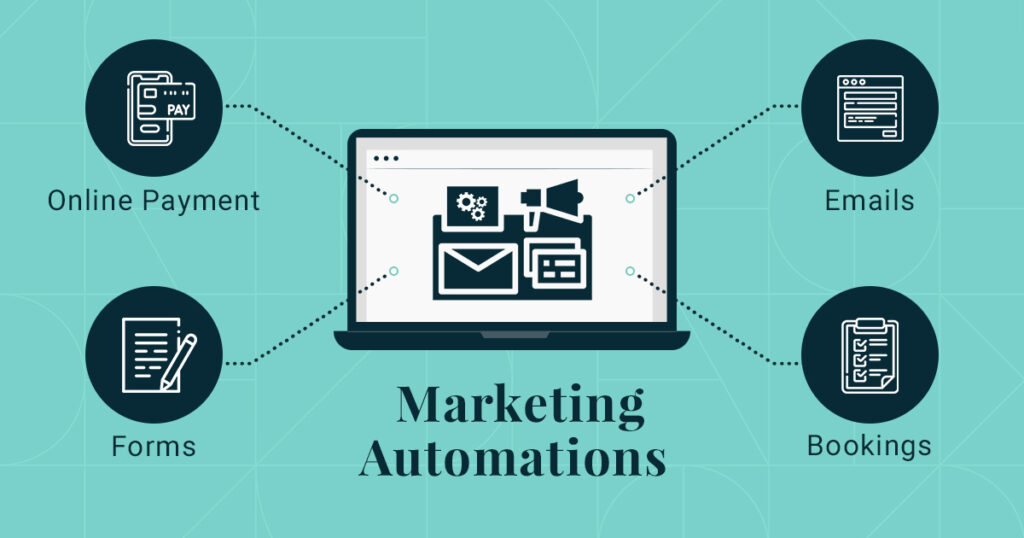
Examples of manual tasks that can be automated:
- Online forms can work powerfully to create credit & other applications, online wills etc.
- Appointment bookings
- Event registrations
- Online payments
- Data collection (sign up forms)
Today’s digital automation technology allows you to not only automate these tasks, provide a better customer experience, and free up your time; it also provides you the opportunity to focus on high-value projects that optimise the business for a competitive advantage.
For example, Forefront Events implemented a simple online event registration on their website which has been able to help thousands of customers register for their 400 hundred events they hold each year.
If you run a recruitment firm, replacing a manual recruitment process by using tools that automatically screen CVs, schedule interviews, phone calls, and gather feedback, can restructure recruitment. This saves significant time, freeing up your employees to focus on more important areas.
Incentives to automation
Save Time
Digital automation not only reduces time spent on manual tasks but also speeds up processes by setting up one-click processes for daily actions. For example, that could mean collating different databases into one auto-updating report or sending automated emails in response to timely action.
Respond faster
A major benefit of automating tasks is that it allows you to quickly collect and organise information, which means you can respond to customer requests quicker. An example of this would be submitting information through online forms for a quick turn-around. Being able to quickly communicate details with customers makes your business look more credible (or stand apart from your competition).
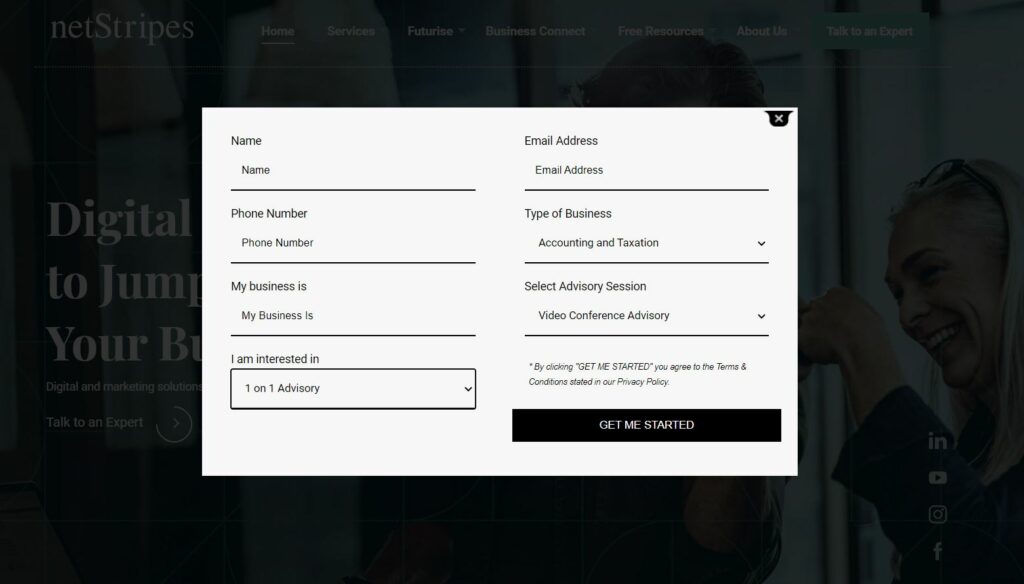
Enhanced productivity
Automation frees up resources for meaningful work – as well as the cognitive space for concentrating on complicated projects. If you use automation to track workflow, you can also discover your productivity patterns and eliminate problematic habits.
Reduce human errors
While manual tasks are prone to human error, automation is almost always precise. Automation that is implemented correctly will capture all important data without misreading and ensures all steps in the process are covered.
One thing to keep in mind when implementing automation – although improving productivity and efficiency is a desirable objective, your digital automation processes should align with a broader business strategy for optimised results.
Data that delivers deep insights for smarter decisions and better results
Although using data for decision-making has been proven to drive better results in business, many business owners still struggle with making data-driven decisions, relying instead on all traditional strategies to do things.
How to make sense of data for best results?
A business generates so much data daily that trying to make sense of it all can leave first-time business owners, and sometimes even experienced ones, extremely frustrated. Let’s talk about your data, and how to make sense of it by dividing it into three levels.
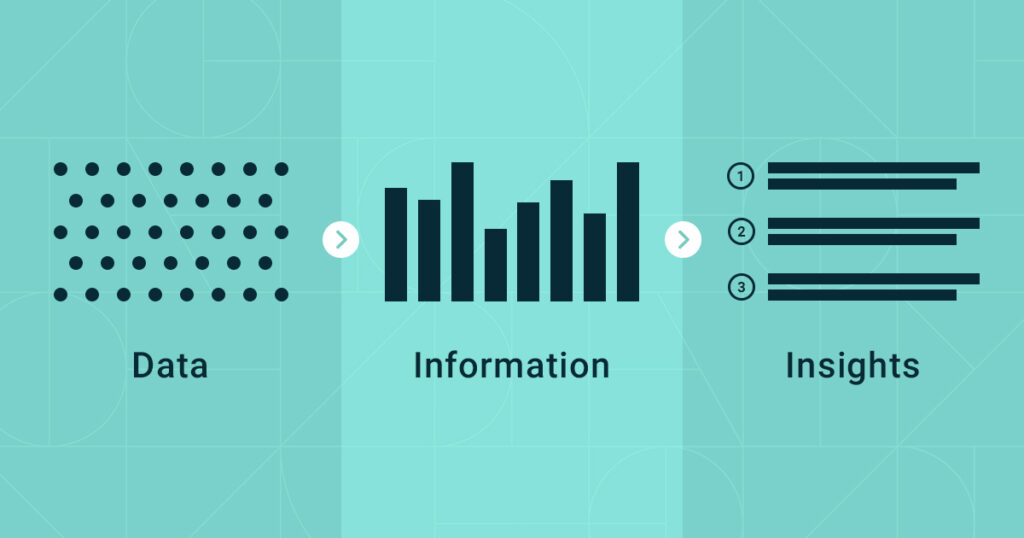
Level 1 – Data
When we talk about data, what we mean is a compilation of raw information. It’s just numbers and stats that’s been generated by a business. For example, take a survey sheet. The spreadsheet that contains all answers is your data.
Level 2 – Information
Information is your data that’s been organised a bit, so it’s easier to read and understand. The best example here is an analytics dashboard that pulls data from a large database or even from multiple areas your website pulling. Trying to read data from multiple sources can be difficult to understand, but the dashboard compiles it in a way that makes the data easier to understand.
Level 3 – Insights
Finally, we have Insights. These are the results of observations, hypotheses, and conclusions based on information/data that’s been analysed. Insights are also the first step towards creating actionable goals, e.g. creating marketing materials based on your conclusion.
How to use data to achieve results
The objective of a data-driven business is to harness data on a daily, weekly, monthly basis, turn it into manageable information, and generate insights that can be used to design result-driven strategies.
You don’t need to spend a lot on data analysis either. Many analytics tools are free, like Google Analytics and social media business accounts. However, it’s important to remember that you need to have an end objective to go from data, insights, and then results.

What is the outcome you want?
There’s so much data freely available online that you can use to gain insights on your customers and competitors, but if you don’t have clarity from the start on the goals you’ve set, and the outcomes you’re expecting, then you won’t be able to come up with a clear strategy on how to achieve it
Commit to a plan
Once you have a goal, you can work on a strategic plan set to strict timelines and resources. Committing to a plan is highly essential to understand what data you need to monitor to build a data-driven marketing approach.
Track all the data available
If you already have an online business, you can track customer interaction and web traffic data from Google Analytics for free. This includes page visits, average time spent, clicks, transactions, number of users, new users, etc.
Aside from Google, there are several tools online that provide reporting and analytics solutions that you can choose for this purpose. Most social media platforms offer insights dashboards to users. As a business owner, it is a must to monitor this data and find out what is working and why it is working for you.
Set KPIs for operations
Selecting key performance indicators in operations and campaigns is an essential step. Because you will have to find out how these KPIs work with your data tracking & analysis process, to track what’s providing results, and what needs improvements.
For example, if one of your KPIs is to grow your customer reach, you should set yourself a target and work towards that by monitoring and analysing the data.
Keep testing for greater results
We’re all guilty of making assumptions in a business based on our previous experience. The best way to know if something is working or not is to A/B Test it. This involves testing user experience by experimenting with two variants at the same time and comparing which variant drives more conversions.
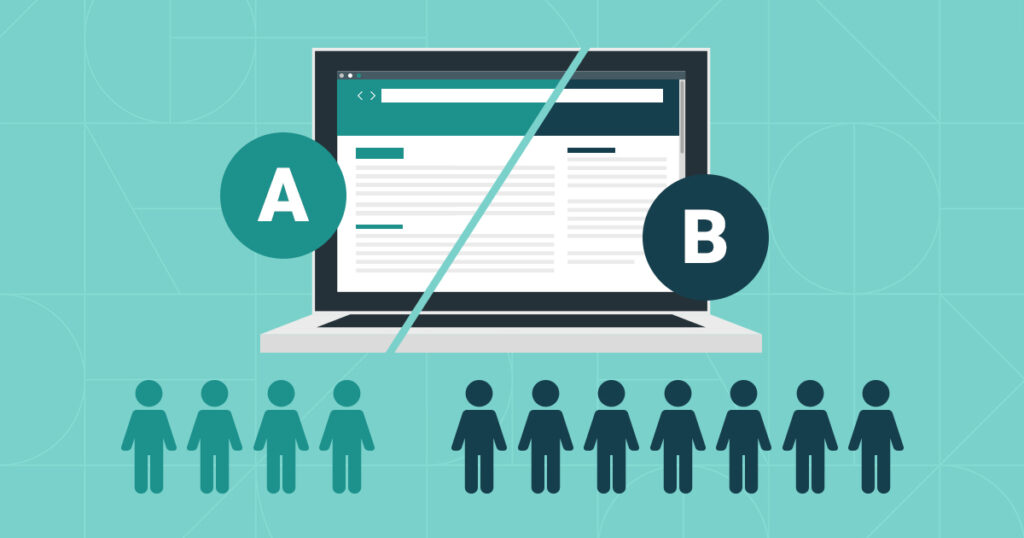
This could be done with Emails, Web Pages, Ads, and Social Media, etc. You can do things like Messaging, Pricing, and Graphics, or even in the case of marketing, time of delivery. The more you test, the more data you’ll have to make improvements in the business.
Digital offers effective and inexpensive communication channels
Today’s consumers live in a 24/7 on-demand digital world where they are exposed to millions of brands and promotional content daily. And these consumers are becoming increasingly adept at tuning out those messages —especially the tech-savvy Gen Y (Millennials) and Gen Z, who make up Australia’s two largest population groups.
When you know who your ideal customers are, your communications become much simpler because you know which digital channels they use and you can prioritise those channels. You’re not wasting resources by not marketing everywhere.
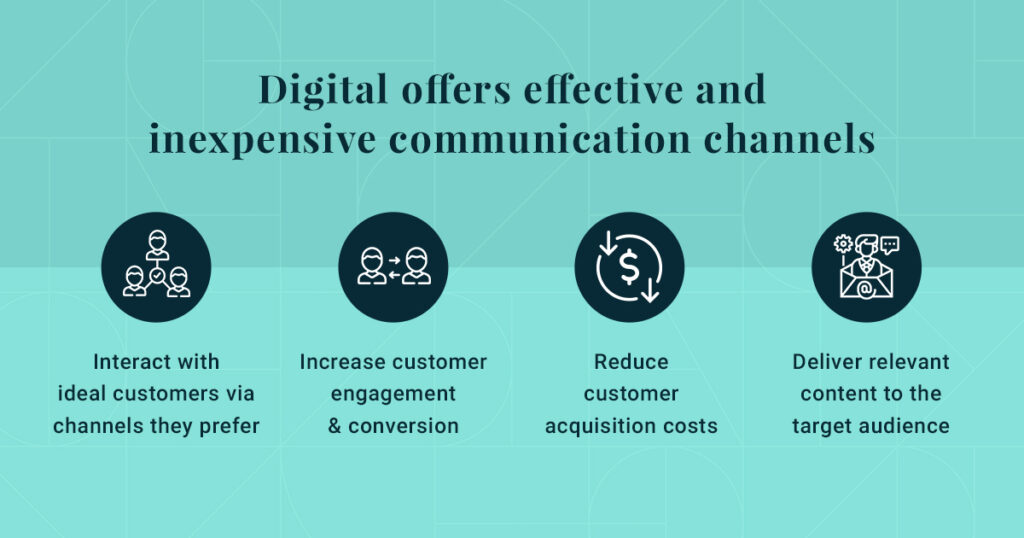
With this in mind, it’s vital to make the shift from traditional methods of communications to one that is focused on conveying persuasive, short-form messages designed to better connect with and engage your audience.
Examples of digital channels
Text Messaging (SMS)
Text messaging is a widely-used channel to communicate quickly and efficiently. However, business owners need to be mindful of data charges and tariffs.
Social Media Platforms
If you deal directly with consumers, odds are you already have multiple social media business accounts for your online marketing.
Emails
The major benefit of Email Marketing is that it is accessible through multiple digital devices, making it more likely to be seen. Blast out promotions or create personalised emails for individuals, send reminders or surveys, email lets you do it all.
Messaging Apps
Messaging platforms like WhatsApp and Facebook Messenger allow businesses to send text messages, images, and video files to customers instantly. You can also create specific groups for your important clients. The best part, unlike text messaging, you don’t need to pay additional charges to send broadcasts to large groups.
GoogleMyBusiness
GoogleMyBusiness (GMB) provides digital solutions for small businesses by allowing you to interact with customers directly through search engine result listings on both mobile and desktop platforms. You can also communicate via My Business messaging, customer reviews, and call tracking through your website.
Live Website Chatbox
People either love chatbots or hate them. But, if used properly, your business can greatly profit from offering customers a convenient channel of communication through live chatboxes on your business website.
Communicating through digital platforms provides a means to reach a wider audience, while also filtering out those who wouldn’t necessarily appreciate what your business has to offer.
As a result, business owners need to work on their customer strategy and pinpoint who their ideal customers are, and their unique needs, then create content that resonates with them on a personal level.

Online Advertising & Support
Save valuable time and money with a complete online marketing plan, created and managed by experts so you can focus on achieving your business goals.
Crisis-proofing your business
If the COVID pandemic has taught us anything, it’s that all businesses need to be able to quickly pivot their business model. Reinvention is key to meeting the needs of a rapidly changing social and economic environment and its impact on small businesses.
Remember, digital transformation is not just another ‘IT project’. Instead, it’s the blend of numerous multi-department projects that transform every aspect of your business to increase digital readiness.
Your customer strategy, service strategy, competitor strategy, branding, and marketing need to be aligned to your digital strategy, which in turn should be designed around your business goals. Only then will you have a complete 360 strategy that supports your digital platforms.
This strategic approach to taking your business online will enable you to pivot during times of uncertainty, and reinvent your business model for success.
The positive effects of digital transformation have been extraordinary for many businesses, and firmly outweigh any reason to not make the transition. If you’re still unsure about making the full transition to digital, increase your digital knowledge through online articles and courses, or get in touch with a professional digital specialist who can help you design a plan for your digital journey.
